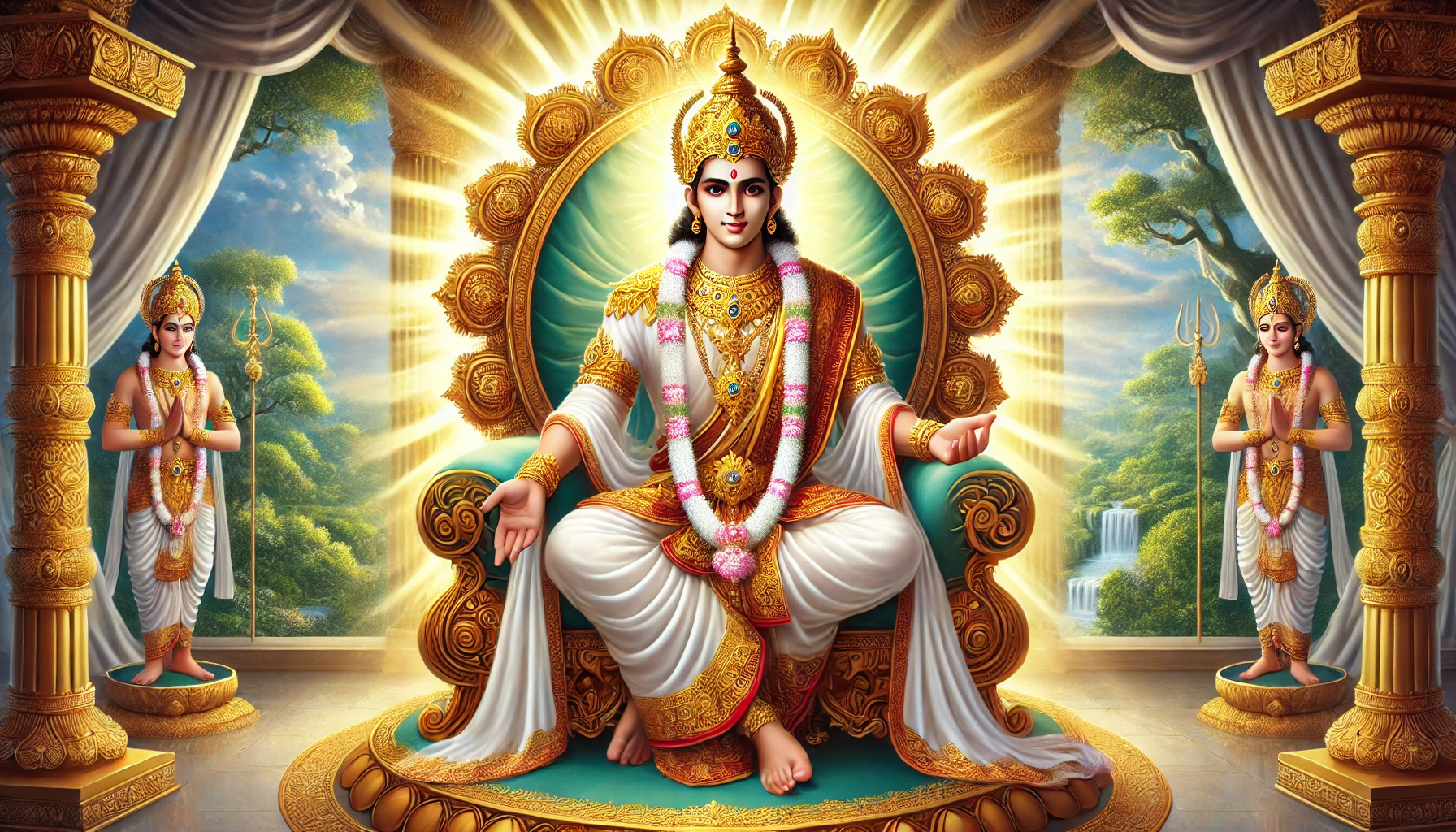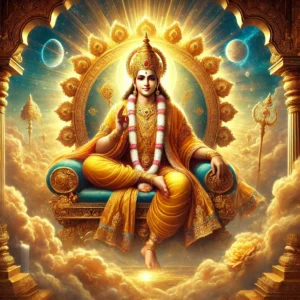
Who is Bali Maharaj in Hindu mythology?
Bali Maharaj: The Benevolent King of the Netherworld
The rich tapestry of Sanatan Dharma is woven with tales of devotion, sacrifice, and the eternal struggle between dharma (righteousness) and adharma (unrighteousness). Among the countless figures who embody these values, Bali Maharaj stands as a shining beacon of selflessness and unwavering faith in the Divine. As the benevolent ruler of the netherworld (Patal Loka), his life story serves as a timeless inspiration for seekers of truth and righteousness.
The Divine Lineage of Bali Maharaj
Bali Maharaj, also known as Mahabali, was born into the illustrious Asura dynasty. He was the grandson of Prahlad Maharaj, the great devotee of Lord Vishnu, who famously stood firm in his faith despite the persecution of his father, the demon king Hiranyakashipu. Following in his grandfather’s footsteps, Bali Maharaj displayed an innate inclination toward dharma, compassion, and devotion to Lord Vishnu.
Despite being an Asura king, a race traditionally depicted as antagonistic toward the Devas, Bali Maharaj broke stereotypes with his virtuous rule. He was loved by his subjects for his fairness and generosity and was celebrated for upholding dharma in its truest sense. His kingdom flourished, and his fame spread far and wide, earning him respect even among the Devas.
Table of Contents
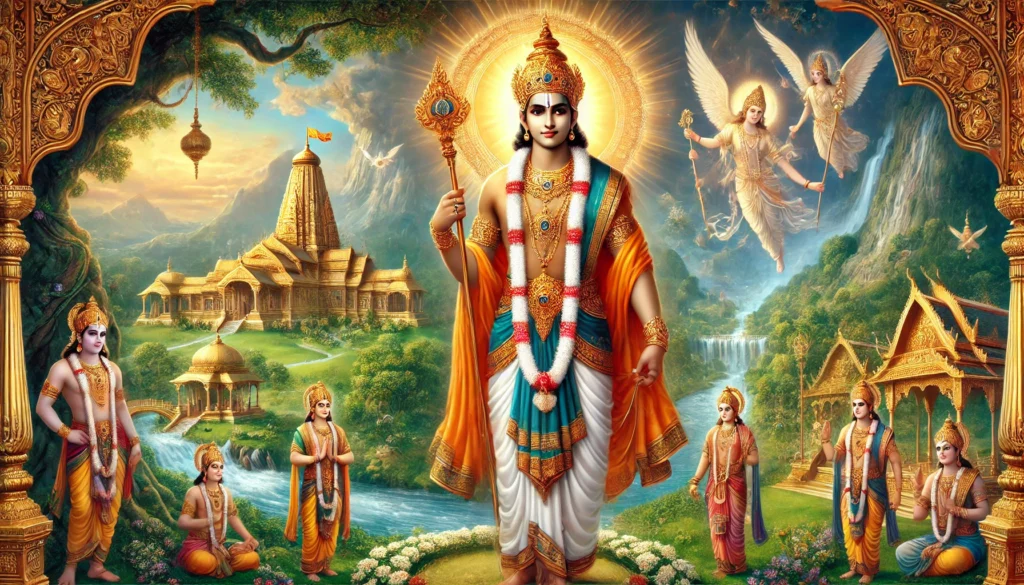
Who is Bali Maharaj in Hindu mythology?
Bali Maharaj’s Rise to Power
Bali Maharaj’s ascent to power was marked by his dedication to dharma and relentless efforts to restore the glory of the Asura dynasty. With the blessings of his guru, Shukracharya, and the merit of his austerities, Bali Maharaj amassed great strength. Through his righteous deeds and unparalleled courage, he successfully expanded his kingdom, bringing the three worlds (heaven, earth, and the netherworld) under his rule.
However, his growing influence unsettled the Devas, who sought refuge in Lord Vishnu. Recognizing the righteousness of Bali Maharaj but also understanding the cosmic balance that needed to be maintained, Lord Vishnu decided to intervene in a manner that would uphold dharma while elevating Bali Maharaj to eternal glory.
The Vamana Avatar: A Divine Test of Devotion
To curb Bali Maharaj’s growing dominance, Lord Vishnu incarnated as Vamana, a dwarf Brahmachari. Disguised as a humble seeker, Vamana approached Bali Maharaj during a grand Ashwamedha Yagna, where the king was granting boons to all in attendance. Vamana requested three paces of land, a seemingly modest request that Bali Maharaj readily granted, despite the warnings of his guru, Shukracharya.
As soon as the boon was granted, Vamana revealed his cosmic form (Trivikrama) and expanded his stature to unimaginable proportions. With one step, he covered the heavens; with the second, he measured the earth. With no space left for the third step, Bali Maharaj, true to his word, offered his own head. This act of surrender was not just a fulfillment of a promise but a profound expression of his devotion and humility.
The Reward of Selflessness
Moved by Bali Maharaj’s sacrifice and unwavering faith, Lord Vishnu did not annihilate him but instead blessed him with immortality and the sovereignty of the netherworld. Furthermore, Lord Vishnu promised to protect Bali Maharaj as his personal gatekeeper in Patal Loka. This divine act not only elevated Bali Maharaj to the status of one of Vishnu’s greatest devotees but also ensured his place as a symbol of dharma and humility in the cosmic order.
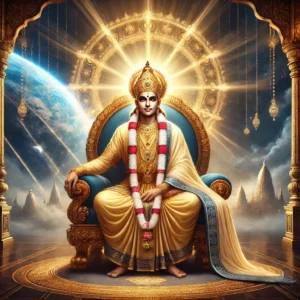
Who is Bali Maharaj in Hindu mythology?
Bali Maharaj’s Annual Visit: The Festival of Onam
The story of Bali Maharaj is celebrated in Kerala during the grand festival of Onam. It is believed that Lord Vishnu granted him the boon of visiting his beloved subjects once a year to ensure their well-being. Onam is thus a joyous occasion that commemorates Bali Maharaj’s selfless rule and his deep bond with his people. Homes are decorated with floral arrangements (Pookalam), sumptuous feasts are prepared, and traditional dances are performed in honor of this benevolent king.
Onam transcends religious boundaries and is a unifying festival, reminding everyone of the values of generosity, humility, and gratitude, which Bali Maharaj embodied.
The Return of Bali Maharaj in Satya Yuga
Scriptures like the Bhagavata Purana and Vishnu Purana prophesy that Bali Maharaj’s story is far from over. At the end of Kali Yuga, when righteousness will be at its lowest ebb, Bali Maharaj is destined to return during Satya Yuga as the next Indra (king of the heavens). He will reestablish dharma, restore balance, and guide humanity toward a golden age of truth and justice. This promise signifies the eternal cycle of dharma, where the forces of righteousness are destined to prevail over adharma.
Lessons from the Life of Bali Maharaj
Bali Maharaj’s life is a treasure trove of spiritual and moral lessons:
The Supremacy of Dharma: Even in challenging circumstances, Bali Maharaj adhered to dharma, demonstrating its universal and eternal nature.
The Value of Sacrifice: True greatness lies in selflessness and the willingness to surrender for the greater good.
Faith in the Divine: Bali Maharaj’s unwavering faith in Lord Vishnu teaches us that devotion transcends material wealth and power.
The Promise of Righteousness: The return of Bali Maharaj during Satya Yuga symbolizes the ultimate triumph of truth and justice.
Conclusion
Bali Maharaj’s story is not merely a tale from ancient scriptures but a timeless reminder of the virtues that sustain the cosmic order. His life exemplifies the eternal bond between the devotee and the Divine, where surrender and faith lead to liberation and glory. As we reflect on his legacy, we are reminded that dharma, no matter how tested, always prevails.
May the story of Bali Maharaj inspire us to walk the path of righteousness, cultivate humility, and strive for selflessness in our daily lives. Let us honor his memory by embracing the values he stood for and by fostering harmony and compassion in the world.
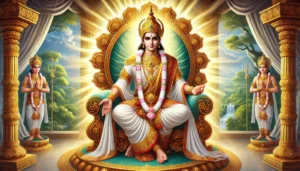
Who is Bali Maharaj in Hindu mythology?
FAQs on “Bali Maharaj: The Devoted King Who Will Restore Dharma in Satya Yuga”
- Who is Bali Maharaj, and why is he considered unique among asuras?
Bali Maharaj, also called Mahabali, was a mighty asura king who ruled with righteousness and compassion. Despite being born into the asura lineage, traditionally seen as adversaries of the devas, Bali stood out for his virtuous nature, generosity, and unwavering devotion to Lord Vishnu. His rule is remembered as a golden era of prosperity and fairness.
- What is the significance of the Vamana Avatar in Bali Maharaj’s life?
The Vamana Avatar of Lord Vishnu played a pivotal role in testing Bali’s devotion and humility. When Vamana asked for three paces of land as alms, Bali generously agreed, even when it meant sacrificing his own kingdom. The Avatar symbolizes the importance of surrendering to divine will and demonstrates that true devotion transcends material wealth and power.
- How did Bali Maharaj achieve immortality?
Bali Maharaj achieved immortality not by living forever in a physical form but through his deeds and divine blessings. After his ultimate surrender, Lord Vishnu granted him the realm of Sutala, a prosperous netherworld, and promised to protect him personally. This eternal bond with Vishnu ensures Bali’s legacy continues through festivals, scriptures, and spiritual teachings.
- Why is Bali Maharaj considered a symbol of dharma and devotion?
Bali Maharaj exemplified dharma by ruling justly, ensuring the welfare of his people, and fulfilling his duties as a king. His devotion to Vishnu, even when tested severely, reflects the essence of bhakti (devotion), where surrender and trust in the Divine take precedence over ego and attachment.
- What role will Bali Maharaj play during the Satya Yuga?
Hindu scriptures prophesize that Bali Maharaj will return to earth during the Satya Yuga as a righteous and benevolent king. He is destined to re-establish dharma, guiding humanity towards a spiritual and ethical renaissance in alignment with divine principles.
- What are the spiritual lessons from the Vamana-Bali interaction?
Humility over pride: Bali, though a powerful ruler, displayed humility in surrendering to Vamana.
Ego dissolution: True spiritual growth requires letting go of ego, as Bali did.
Divine testing: Challenges in life are often divine tests of faith and character.
Devotion above all: Bali’s story proves that unwavering devotion and surrender to God lead to eternal grace.
- How is Bali Maharaj celebrated during Onam?
In Kerala, the festival of Onam commemorates the annual visit of Bali Maharaj to his people. It is believed that Vishnu granted him the boon of visiting his subjects once a year. Onam is marked by joyous festivities, including traditional feasts, dances, and decorations, symbolizing the prosperity and harmony of Bali’s reign.
- What is Sutala, and why was Bali Maharaj sent there?
Sutala is a realm in the netherworld, bestowed upon Bali Maharaj by Lord Vishnu after his surrender. It is described as a prosperous and divine kingdom where Bali rules with Vishnu’s protection. Sutala represents spiritual ascension, as Bali’s devotion elevated him beyond the material plane.
- How is Bali Maharaj connected to Diwali and Bali Pratipada?
In many parts of India, Bali Pratipada is observed on the fourth day of Diwali to honor Bali Maharaj. It celebrates his generosity, devotion, and the promise of his return. The festival also symbolizes the victory of humility and dharma over pride and ego.
- What does Bali Maharaj’s story teach about power and responsibility?
Bali Maharaj’s story emphasizes that power should be used to serve others selflessly. Despite being an asura king, Bali prioritized the well-being of his people and upheld dharma. His ability to relinquish his kingdom for a higher purpose highlights the true essence of leadership and responsibility.
- Why is Bali Maharaj’s devotion considered ideal?
Bali Maharaj’s devotion is celebrated because it was unconditional and selfless. Even when faced with the loss of his kingdom and personal challenges, he remained steadfast in his faith in Lord Vishnu. This pure and unwavering surrender serves as a model for spiritual aspirants.
- How does Bali Maharaj’s story connect to modern values?
Bali Maharaj’s story underscores timeless values such as humility, generosity, and devotion. In today’s world, his life inspires individuals to lead with compassion, prioritize collective well-being, and remain committed to their spiritual beliefs, even in the face of challenges.
- What is the relevance of Bali Maharaj’s story in the context of karma?
Bali Maharaj’s journey illustrates the law of karma—how selfless actions and devotion yield divine grace. His willingness to sacrifice his kingdom for dharma resulted in blessings from Lord Vishnu, ensuring his eternal glory and spiritual ascension.
- How is Bali Maharaj portrayed in different Puranas?
Bali Maharaj’s story is narrated in various Puranas, including the Bhagavata Purana, Vishnu Purana, and Mahabharata, with slight variations. All accounts emphasize his virtues, his encounter with Vamana, and his eventual role in upholding dharma during the Satya Yuga.
- What does Bali Maharaj’s return symbolize for humanity?
The prophesied return of Bali Maharaj during the Satya Yuga symbolizes hope, renewal, and the triumph of dharma over adharma. It serves as a reminder that divine intervention ensures justice and righteousness prevail, even in the darkest times.
- How does Bali Maharaj’s story inspire devotion to Lord Vishnu?
Bali Maharaj’s ultimate surrender to Vamana demonstrates the transformative power of bhakti. His life inspires devotees to place complete faith in Vishnu, trusting that His will leads to spiritual elevation and eternal grace.
- Why is Bali Maharaj a symbol of unity in diversity?
As an asura king who achieved divine grace, Bali Maharaj bridges the gap between devas and asuras, highlighting that virtues like devotion, humility, and dharma transcend social and cosmic divisions. His story teaches inclusivity and the universality of spiritual ideals.
Summary
Bali Maharaj: The Devoted King Who Will Restore Dharma in Satya Yuga
Bali Maharaj, a prominent figure in Sanatan Dharma, is celebrated as a benevolent and righteous king who ruled the netherworld (Patal Lok) with justice and compassion. Despite being born into the asura lineage, his unwavering devotion to Lord Vishnu set him apart as a virtuous soul.
The story of Bali Maharaj reaches its pinnacle during the Vamana Avatar of Lord Vishnu. In his quest to uphold dharma, Bali Maharaj offered three paces of land to Vamana, a dwarf Brahmin who was none other than Vishnu in disguise. Vamana covered the entire cosmos in two steps, leaving no space for the third. Demonstrating unparalleled humility and devotion, Bali offered his own head for the third step, thereby surrendering himself completely to the Lord.
As a result, Bali Maharaj was blessed by Lord Vishnu and granted the rulership of the netherworld. Vishnu also promised to guard Bali’s kingdom as his doorkeeper and assured him that he would return during the Satya Yuga to establish dharma once again. This act of surrender, devotion, and divine grace signifies the eternal bond between the devotee and the divine.
The legacy of Bali Maharaj is commemorated during festivals like Onam, celebrating his virtues, devotion, and the promise of his return to restore righteousness in the world.
Related Articles
- Restful Nights: Ayurvedic Remedies and Traditional Indian Practices to Overcome Insomnia and Late-Night Habits
- The Tridevi: Lakshmi, Saraswati, and Parvati – Their Roles and Powers
- “Divine Creatures of Ancient Indian Scriptures: Exploring the Role of Animals in the Vedas, Puranas, and Mahabharata”
- Nature and Spirituality: Exploring the Sacred Essence of the Himalayas, Ganga, and Other Natural Wonders”
- “Reviving the Gurukul System: Relevance and Lessons for Modern Education”
- “Exploring Greek and Indian Mythology: Similarities Between Greek and Indian Mythology “
- “Embracing Sattvic Living: Harmonizing Mind, Body, and Soul Through Food and Lifestyle”
- “Charity and Prosperity: Exploring the Concept of Daan and Its Financial Relevance in Modern Life”
- How to Build an Eco-Friendly Home Inspired by Vastu Shastra
- Comparison of Ancient and Modern Sports: How Traditional Sports Have Influenced Contemporary Games
- “Timeless Lessons from Ancient Tales: Linking Samudra Manthan and Ganga’s Descent to Modern Ecological Challenges”
- “Reviving Sanskrit: How AI is Preserving Ancient Languages for the Future”
- “Mathura: The Sacred Land of Lord Krishna’s Divine Leelas”
- Investing for Future Generations: Lessons from Indian Traditions on Legacy Building and Wealth Preservation
- “Ancient Indian Wisdom: Timeless Lessons for Tackling Today’s Climate Crisis”
- “Artificial Intelligence and Spirituality: Transforming Ancient Practices for the Modern World”
- “Gold and Real Estate in India: Timeless Assets Shaping Financial Strategies”
- Tradition Meets Innovation: The Evolution of Technology in Hindu Rituals
- End-of-World Myths: Exploring Kali Yuga in Hinduism and Ragnarök in Norse Mythology
- Garuda, Pegasus, and Dragons: The Universal Ties of Mythical Beasts Across Cultures
- “Ancient Vimanas: Mythical Flying Machines or Evidence of Advanced Technology?”
- Time Travel in Hindu Mythology: The Fascinating Tales of Kakudmi and King Raivata
- “Divine Feminine Power in Hindu Mythology: The Legends of Durga, Saraswati, and Lakshmi”
- “Divine Beings of Sanatan Dharma: The Spiritual Significance of Sacred Animals in Hinduism”
- “Symbolism in Mythological Art: Unlocking Hidden Meanings in Ancient Temple Carvings”
- “Exploring Technological Advancements in Ancient India and Civilizations: Vimana, Metallurgy, & Water Management systems”
- Unveiling the Mysteries: Ancient Temples of Sanatan Dharma , Mysterious Temples of India
- “The Scientific Knowledge of Sanatan Dharma: Ancient Wisdom Meets Modern Science”
- Ancient Indian Sports and Games: Celebrating a Legacy of Skill, Strength & Strategy”
- “Exploring the Cosmic Link: The Connection Between Astronomy and Vedic Astrology”
- The Power of Sanskrit: Unlocking the Divine Language of the Gods
- “The End of Kaliyuga: A Sanatan Insight into the World’s Final Chapter”
- Explore more articles on Prachin Sanatan Yuga.

